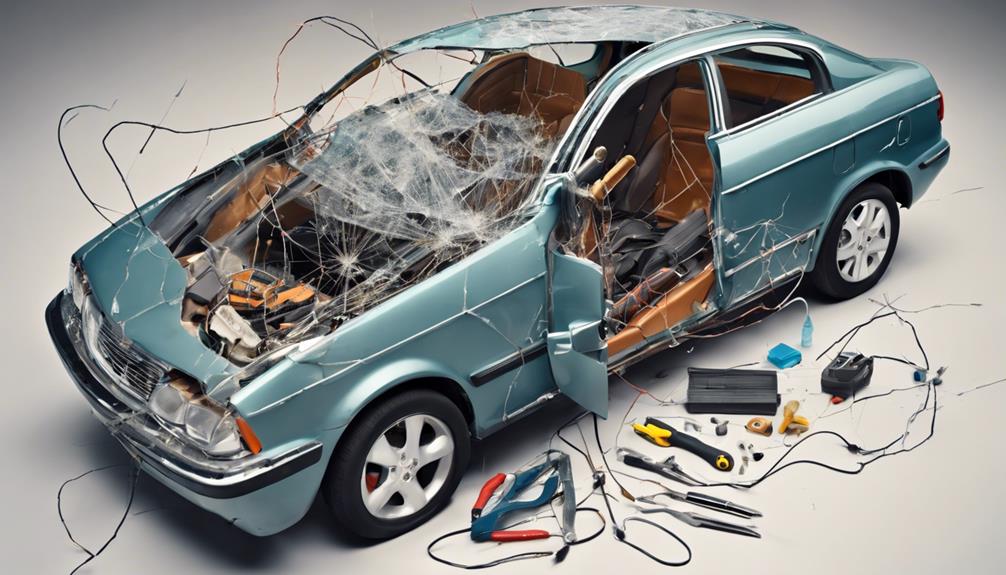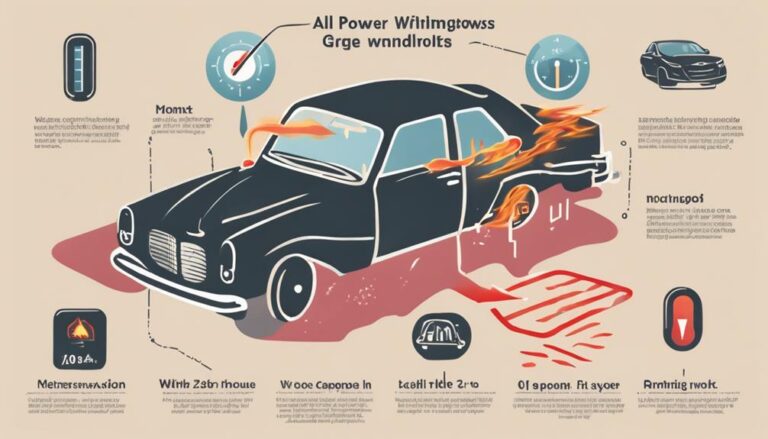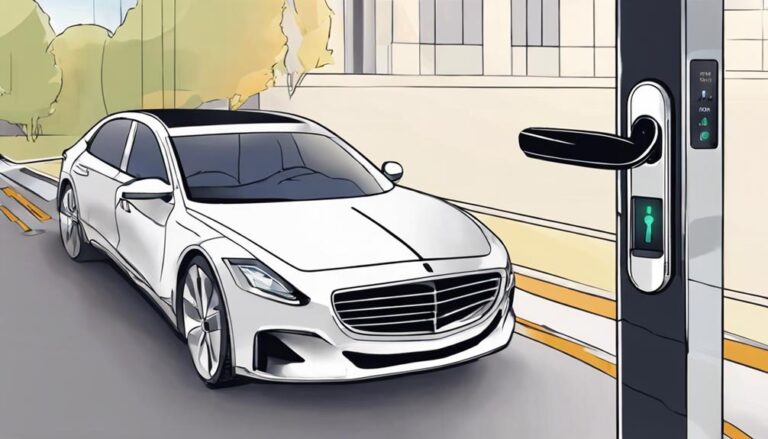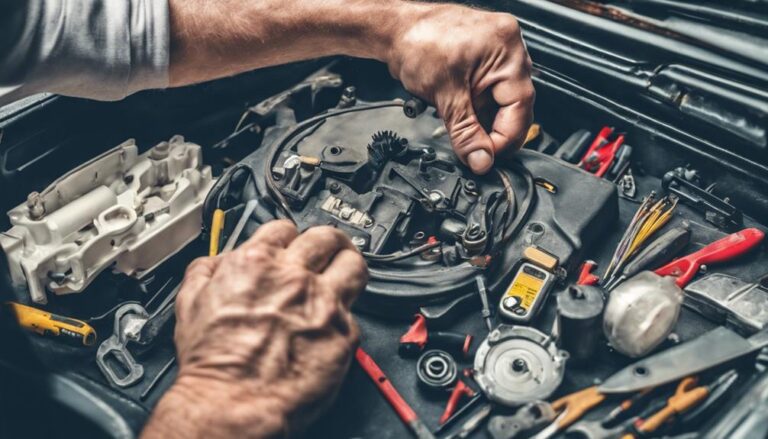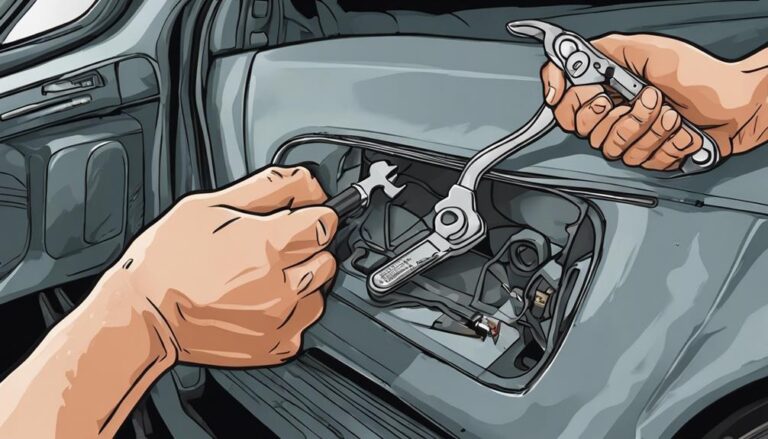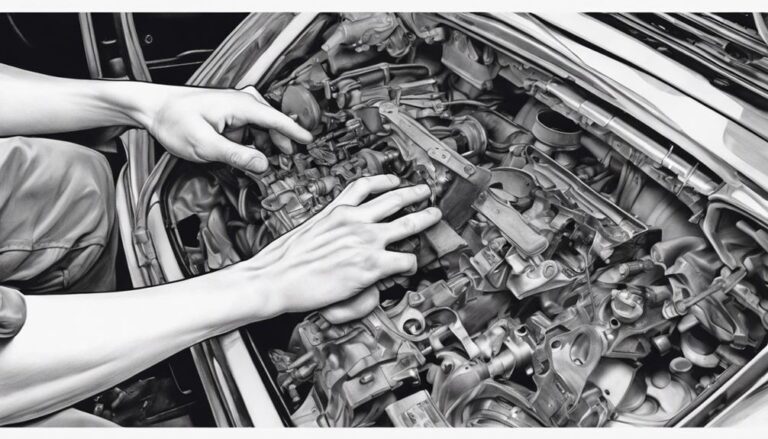Top 10 Causes of Power Window Failure
You rely on your power windows to smoothly glide up and down, but have you ever wondered what causes them to suddenly stop functioning?
From faulty window regulators to corroded connectors, the top 10 causes of power window failure can leave you stranded with a window that won't budge.
Discovering these culprits early on could save you from the inconvenience of a malfunctioning power window, so let's explore these common issues and how to address them effectively.
Key Takeaways
- Faulty window regulators and malfunctioning motors are common causes of power window failure.
- Electrical wiring issues and broken window switches can disrupt power window functionality.
- Power supply problems like blown fuses can lead to power window failure.
- Regular maintenance, including proper lubrication and addressing off-track windows, is crucial for optimal power window operation.
Faulty Window Regulator
If you experience unusual noises or slow movement in your power window, a possible cause could be a faulty window regulator. The window regulator plays an important role in controlling the up-and-down movement of the window glass. Over time, the internal components of the window regulator can wear out, leading to issues with the smooth operation of your power window.
Signs of a faulty window regulator include strange noises emanating from the door panel when you attempt to operate the window, as well as slow or intermittent movement of the window glass. These symptoms can be frustrating and impact the overall functionality of your power window. In such cases, it's essential to address the faulty window regulator promptly to guarantee proper window function.
To rectify this issue, replacement of the window regulator may be necessary. It's advisable to consult the service manual or seek assistance from a professional to guarantee the correct installation of a new window regulator. By addressing a faulty window regulator promptly, you can restore smooth and efficient operation to your power window system.
Malfunctioning Window Motor
The window motor in your vehicle is responsible for powering the movement of the power window glass. When this motor malfunctions, it can lead to issues like slow or uneven window movement.
Look out for signs such as grinding or clicking noises, or total failure of the power window to operate properly.
Motor Overheating Causes
Motor overheating in power window systems can be attributed to a malfunctioning window motor due to continuous operation without proper cooling. When the window motor is overworked, it generates excess heat, leading to overheating.
This can result in intermittent issues like slow or jerky movement of the power window. The high temperatures in the motor can compromise its performance and may ultimately cause burnout.
To prevent such problems, it's important to make sure that the window motor receives adequate cooling and maintenance. Regular checks on the motor's condition can help identify potential overheating issues early on, prolonging the lifespan of the power window system and avoiding inconvenient failures.
Common Motor Problems
A malfunctioning window motor commonly disrupts the smooth operation of power windows, manifesting through symptoms like slow or jerky movements, unusual noises, or complete failure.
When dealing with common motor problems, consider the following:
- Testing Power Supply: Diagnose if the window motor is the key cause by checking the power supply.
- Signs of Malfunction: Look out for slow or jerky movements, unusual noises, or total window failure.
- Essential Replacement: Often, replacing a faulty window motor is necessary to restoring proper functionality.
- Prompt Attention: Addressing issues promptly can prevent further damage, ensuring the safety and convenience of your vehicle's power windows.
Understanding these common causes of power window motor issues can help you diagnose and repair them effectively.
Electrical Wiring Issues
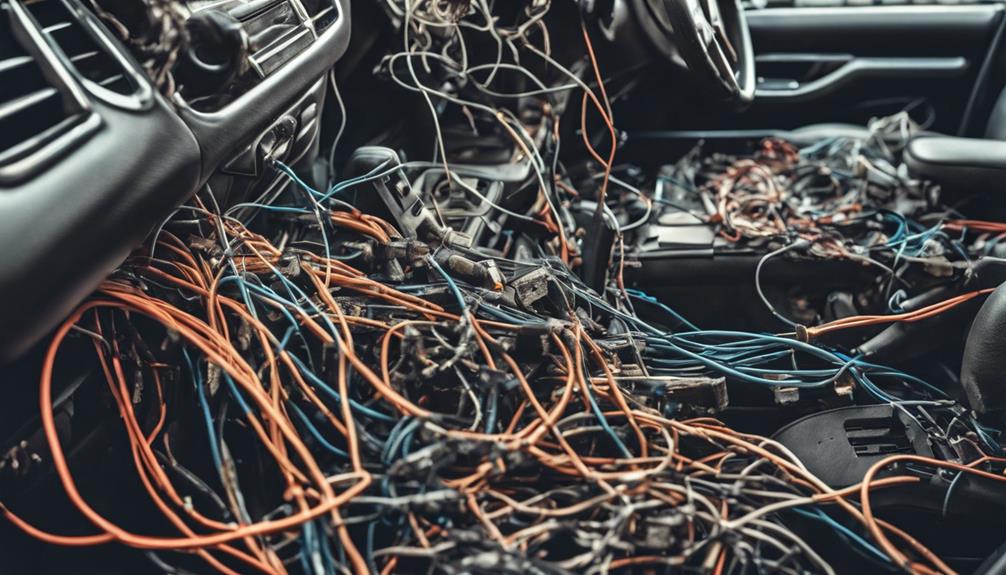
Identifying and addressing electrical wiring issues is essential in troubleshooting power window failures. When electrical faults occur, such as damage, fraying, or disconnection of wires, the power windows may cease to function properly.
Corrosion or loose connections within the wiring can disrupt the electrical signals essential for the operation of the power windows. This disruption can lead to a loss of power to the window motor, ultimately rendering the window inoperable.
Seeking professional help may be necessary to accurately diagnose and rectify these wiring issues. Trained technicians have the expertise to inspect, identify, and repair any faulty wiring that may be contributing to the malfunction of the power windows.
It's important to address these wiring issues promptly to ensure the best performance of your power windows and prevent further complications.
Broken Window Switch
Experiencing power window failure? The broken window switch could be the likely culprit. When the power window switch malfunctions, it can hinder your ability to control the windows, causing inconvenience and affecting the overall functionality of your vehicle.
Here's what you need to know about this common cause of power window issues:
- Wear and Tear: The power window switch is prone to wear and tear on its electrical components, leading to failure over time.
- Inoperable Windows: A broken window switch can render your power windows inoperable, making it impossible to open or close them as desired.
- Erratic Behavior: If you notice erratic behavior when using the window switch, such as the window moving unexpectedly or not responding to commands, it could indicate a faulty switch.
- Diagnosis and Repair: Testing the window switch for power output can help diagnose if it's the cause of the problem. In most cases, replacing the broken window switch is necessary to restore proper function to the power windows.
Blown Fuse
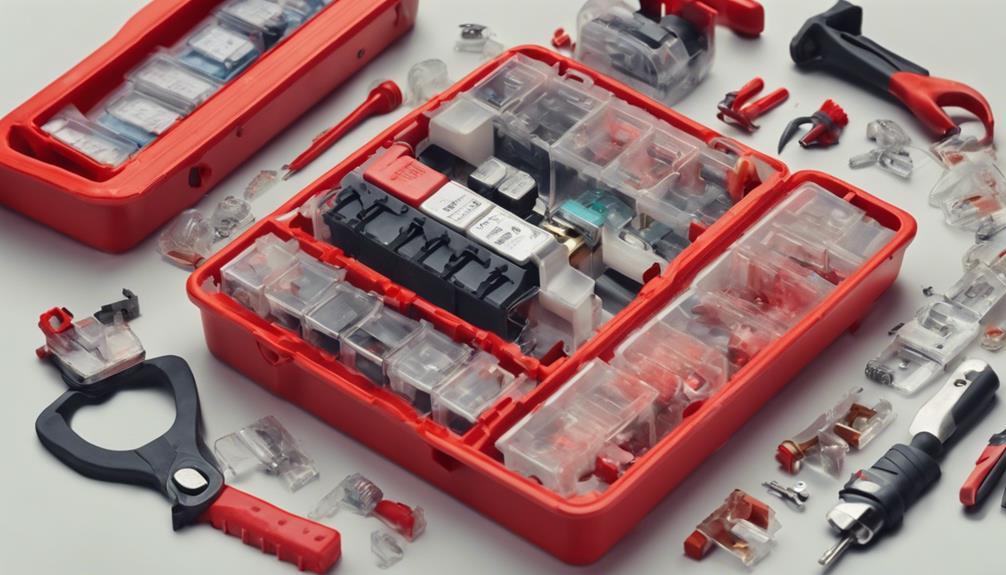
To identify a blown fuse as a potential cause of power window failure, inspect the fuse box for any signs of damage or discoloration. A blown fuse can disrupt the power supply to the power window system, leading to power window failures. Fuses play an important role in safeguarding electrical components like power windows from electrical overloads. Checking and replacing a blown fuse is a fundamental step in troubleshooting power window issues. Blown fuses may result from electrical faults, short circuits, or excessive current draw within the power window circuit.
When facing power window problems, examining the fuses is an important diagnostic measure. If a fuse is blown, addressing it promptly can help restore power window functionality and prevent further damage to the system. Remember, fuses are inexpensive components designed to protect more costly electrical parts. Ensuring that the fuses are intact and in good condition is essential for the proper functioning of your power windows.
Water Damage
Water damage often leads to power window failure by corroding electrical components and causing malfunctions within the system. When water infiltrates the door panel, it can have detrimental effects on the power window system. Here's a breakdown of how water damage impacts power windows:
- Short Circuits: Rainwater seeping into the door panel can result in short circuits, leading to erratic behavior in the power window operation.
- Component Damage: Water infiltration can harm essential parts like the window motor, regulator, and switches, impairing their functionality.
- Moisture Build-Up: Accumulated moisture in the door cavity can promote rust and deterioration of power window components, affecting their longevity.
- System Failure: Severe water damage can cause complete failure of the power window system, necessitating extensive repairs to restore functionality.
To prevent water damage from compromising your power windows, make sure proper sealing and address any leaks promptly to safeguard the electrical components and mechanisms within the system.
Lack of Lubrication

Insufficient lubrication in power window mechanisms can accelerate friction levels, leading to accelerated wear and tear on critical components. When the window motors lack proper lubrication, they can face increased resistance, causing strain on the mechanical components. This can result in a range of mechanical issues, ultimately leading to the window stops working altogether. Regular maintenance, including lubrication of window tracks and rollers, is vital to prevent these issues.
| Window Motor Lubrication | Mechanical Issues | Impact on Window Operation |
|---|---|---|
| Insufficient lubrication can lead to increased friction in the motor. | Lack of lubrication can cause grinding noises during window operation. | Without proper lubrication, the window may become slow or jerky in movement. |
| Proper lubrication helps reduce wear on motor components. | Neglecting lubrication can result in sticking windows. | Lubrication maintenance prevents premature failure of the window motor. |
| Lubrication ensures smooth operation of the window regulator. | Lack of lubrication increases the chances of motor overheating. | Regular lubrication extends the lifespan of the power window system. |
Window Off Track
If your power window is off track, it may indicate a misaligned window mechanism or a broken window regulator.
This misalignment can lead to difficulty in opening or closing the window smoothly.
To address this issue, it's important to inspect and repair the window regulator or track to guarantee proper alignment and functionality.
Misaligned Window Mechanism
Experiencing a misaligned window mechanism, commonly known as a window off track, is often indicative of worn-out or damaged components within the power window system. Signs of misalignment include the window not closing properly or appearing crooked in the door frame. This misalignment can cause extra strain on the window motor and regulator, potentially leading to more extensive damage. To rectify this issue, realigning the window glass within the tracks and replacing any damaged parts may be necessary. Regular maintenance and immediate repairs are vital in preventing a misaligned window from causing further power window complications.
- Signs of Misalignment: Window not closing properly, crooked window in the door frame.
- Potential Damage: Strain on the window motor and regulator.
- Repair Process: Realign window glass, replace damaged components.
- Prevention: Regular maintenance, prompt repairs.
Broken Window Regulator
A broken window regulator, also known as the window being off track, is a common issue that can lead to power window failure. The window regulator is responsible for controlling the movement of the window glass, and over time, it can wear out, causing the window to malfunction. Signs of a broken window regulator include strange noises, slow or irregular window operation, and the window not remaining in its intended position.
To address this problem, replacement of the window regulator may be required. It's advisable to refer to the service manual or seek assistance from a professional for proper installation. Promptly addressing a broken window regulator is essential to prevent further damage and ensure the efficient operation of the power window.
Corroded Connectors
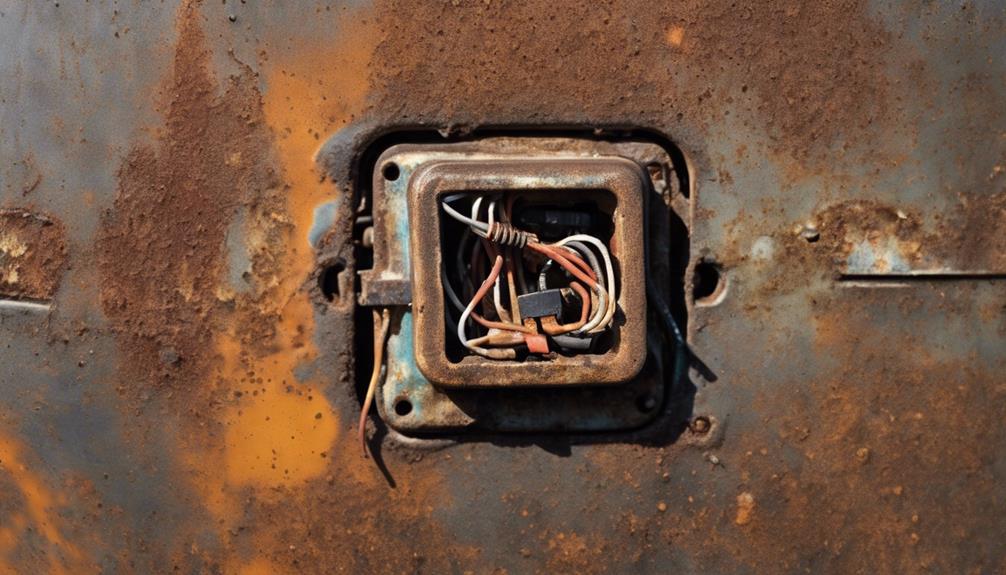
Corroded connectors in power window systems can disrupt the electrical signal required for proper operation. When these connectors become corroded, they can impede the flow of electricity, impacting the ability of the power window to function correctly.
Here are some key points to contemplate regarding corroded connectors:
- Electrical Signal Disruption: Corrosion on connectors can interrupt the electrical signal necessary for the power window to operate smoothly.
- Poor Contact: Corrosion can lead to poor contact between the connectors, resulting in erratic behavior of the power window.
- Moisture and Debris: Factors like moisture and debris can accelerate the corrosion process on connectors, affecting the overall performance of the power window system.
- Preventive Maintenance: Regular inspection and cleaning of connectors are essential to prevent power window failure caused by corrosion, ensuring peak functionality.
Defective Window Control Module
If you notice your power windows behaving erratically or failing to function, a defective window control module could be the culprit. Symptoms of module malfunction may include slow window movement or complete inactivity.
Understanding repair and replacement options, as well as the compatibility of control modules with your vehicle, is essential for addressing this issue effectively.
Module Malfunction Symptoms
Symptoms of a defective window control module may manifest as windows becoming stuck, moving slowly, or failing to respond to commands. When your module malfunctions, it can lead to erratic behavior in your power windows. Here are some signs to look out for:
- Intermittent Operation: Windows may work sporadically or stop functioning altogether.
- Slow Movement: Windows might take longer than usual to open or close.
- Unresponsive Controls: Commands to operate the windows may not yield any action.
- Erratic Behavior: Windows may open or close unexpectedly, showing a lack of control.
If you notice any of these symptoms, it's advisable to address the issue promptly to avoid further complications.
Repair and Replacement Options
When experiencing symptoms of a defective window control module, seeking repair and replacement options becomes necessary to restore proper function to your power windows. The window control module is an essential component responsible for regulating the operation of your power windows. If this module fails, you may encounter issues such as erratic window behavior or complete malfunction. To address this, consider the following repair and replacement options:
| Repair Options | Replacement Options | Professional Help |
|---|---|---|
| Check the switch connections | Replace the entire module | Consult a mechanic |
| Inspect the door panel for damage | Install a new window control module | Seek assistance from an auto electrician |
| Test the power windows for functionality | Consider aftermarket options | Contact a car dealership for specialized support |
Common Vehicle Compatibility
Defective window control modules are prevalent in a wide range of vehicles from different manufacturers, necessitating attention to guarantee proper functionality of power windows. When it comes to common vehicle compatibility issues related to defective window control modules, consider the following:
- Diverse Manufacturer Impact: Vehicles from Honda, Toyota, Ford, and GM may experience defective window control modules.
- Module Malfunctions: These modules can suffer from internal faults or electronic component failures affecting the power window system.
- Symptoms to Watch: Look out for erratic window operation or complete window failure as signs of a faulty control module.
- Necessary Replacement: To rectify these issues, replacement of the defective window control module is essential for restoring proper window function in affected vehicles.
Frequently Asked Questions
What Is the Most Common Issue With Power Windows?
The most common issue with power windows is a faulty window regulator. It controls the window's movement. When it malfunctions, you may experience slow or erratic operation. It's important to address this promptly to make sure your window works smoothly.
What Would Cause All My Power Windows to Stop Working?
If all your power windows suddenly stop working, it might be due to a window regulator malfunction, electrical wiring issues, or problems in the fuse box. These components need to be inspected to pinpoint the root cause.
What Causes a Power Window Switch to Go Bad?
When power window switches go bad, it's usually due to electrical connections wearing out over time. Moisture and corrosion can infiltrate, causing faults. Faulty wiring and overheating are common culprits. Keep an eye on these factors for smooth operation.
How Do You Diagnose an Electric Window Fault?
To diagnose an electric window fault, troubleshoot using these techniques: check fuses and relays, test the master switch for power supply, look for lockout switches, use a volt meter on the motor, and inspect wiring for damage.
Conclusion
After exploring the top 10 causes of power window failure, it's clear that a combination of mechanical and electrical issues can lead to malfunction.
From faulty regulators and motors to wiring issues and blown fuses, the root of the problem can vary.
By addressing these issues promptly and seeking professional diagnosis and repair, you can guarantee smooth and efficient operation of your power windows.
Stay proactive and keep your windows functioning properly to avoid further damage.

